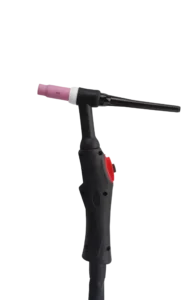Table of Contents
ToggleIntroduction of TIG welding
TIG (Tungsten Inert Gas) welding, also known as GTAW (Gas Tungsten Arc Welding), is a popular welding process used in various industries. One of the key components of TIG welding is the TIG gun. Now we will explore the advantages of using a TIG gun for welding and how it enhances the welding process.
Precision and Control
The TIG gun offers exceptional precision and control during the welding process. The gun’s design allows for precise manipulation of the arc, ensuring accurate weld placement and minimizing the risk of errors. Welders can easily adjust the heat and amperage settings, allowing for greater control over the welding process, resulting in high-quality welds.
Versatility
TIG gun welding is highly versatile and can be used to weld a wide range of materials, including stainless steel, aluminum, copper, and exotic metals. By adjusting the settings and using appropriate filler materials, welders can achieve strong and clean welds on different materials, making it a preferred choice for various industries, such as automotive, aerospace, and fabrication.
Clean and Aesthetic Welds
TIG welding with a TIG gun produces clean and aesthetic welds. The process uses a non-consumable tungsten electrode, which creates a precise and focused arc. The shielding gas, typically argon, protects the weld area from atmospheric contamination, resulting in welds with minimal spatter, slag, or porosity. This clean and visually appealing appearance is highly desirable, especially in applications where aesthetics are crucial, such as architectural metalwork or jewelry fabrication.
Heat Control and Weld Quality
TIG gun welding allows for excellent heat control, which is essential for achieving high-quality welds. The welder can precisely control the heat input, minimizing the risk of overheating or warping the base material. This level of control is particularly advantageous when working with thin or heat-sensitive materials, as it helps prevent distortion and ensures the integrity of the weld joint.
No Flux or Fumes
Unlike some other welding processes, TIG gun welding does not require the use of flux. Flux is a material used to protect the molten weld pool from oxidation. The absence of flux in TIG welding eliminates the need for post-weld cleaning or removal of slag, saving time and effort. Additionally, TIG welding produces minimal fumes, making it a safer and healthier option for welders.
Welding in Tight Spaces
The compact size and maneuverability of TIG guns make them ideal for welding in tight and hard-to-reach spaces. The slim design of the TIG gun allows welders to access confined areas with ease, enabling them to perform precise welds in complex assemblies or structures. This advantage is especially valuable in applications where accessibility is limited, such as pipe welding or welding inside machinery.
The TIG gun is a valuable tool in the welding industry, offering numerous advantages that contribute to the overall quality and efficiency of the welding process. Its precision, versatility, and control enable welders to produce clean and aesthetic welds on various materials. The heat control and absence of flux or fumes further enhance the weld quality and safety. Additionally, the ability to weld in tight spaces expands the scope of applications where TIG gun welding can be utilized.
Whether in automotive, aerospace, or other industries, the advantages of using a TIG gun for welding make it a popular choice among welders seeking high-quality, precise, and visually appealing welds. With proper training and practice, welders can harness the power of the TIG gun to achieve outstanding results in their welding projects.
We Are Cnaweld
The ChiNa Welding Equipment Company’s history began in 2003, when it was founded with the goal of providing high-quality welding equipment to customers around the world. Since then, ChiNa has grown significantly, and it now boasts a wide range of products that are used in a variety of applications, from heavy industry to light fabrication.

